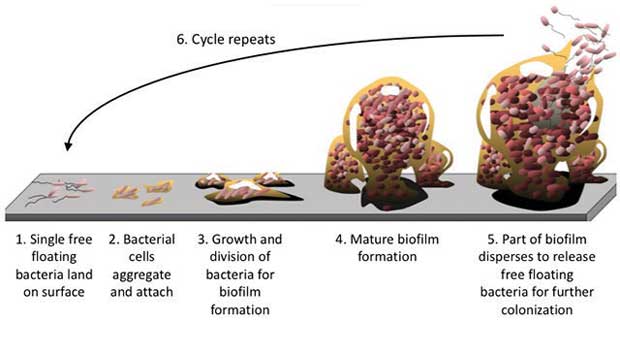Reply To:
Name - Reply Comment

 It’s easy to appreciate the need to disinfect germs on surfaces, but have you ever wondered how germs exist on surfaces in the first place? Enter the biofilm. In recent years, scientists have increased their understanding of these dense colonies of bacteria that produce an extracellular material that binds a community of different microorganisms together and anchors them to both living and inanimate surfaces.
It’s easy to appreciate the need to disinfect germs on surfaces, but have you ever wondered how germs exist on surfaces in the first place? Enter the biofilm. In recent years, scientists have increased their understanding of these dense colonies of bacteria that produce an extracellular material that binds a community of different microorganisms together and anchors them to both living and inanimate surfaces.

Biofilms are traditionally associated with wet or damp surfaces. They form on the surface of catheter lines, pacemakers, heart valve replacements, artificial joints, other surgical implants and in hospital showers. However, biofilms have also been discovered recently on dry hospital surfaces. Bacteria growing in a biofilm are highly resistant to antibiotics, up to 1,000 times more resistant than the same bacteria not growing in a biofilm. Standard antibiotic therapy is often useless and the only recourse may be to remove the contaminated implant which will cause a lot of suffering to the patient.
Biofilms are involved in numerous diseases. For instance, cystic fibrosispatients have Pseudomonas infections that often result in antibiotic resistant biofilms. Fungal biofilms cause chronic vaginal infections and lead to life-threatening systemic infections in people with weak immune systems. So what should we do about biofilms on hospital surfaces? It seems that a daily light cleaning with existing products will do little more than feed and water these biofilms. The world also needs to wake up to the fact that biofilms are present on dry hospital surfaces and that this is a problem we need to address.
One reason for the failure of eradication measures is that historically, we have not developed hospital decontamination protocols with biofilms in mind. Therefore, biofilms should also be considered when developing future hospital decontamination protocols. Defining hospital areas according to the risk of infection is another effective method. Areas where contamination is expected such as laboratories, operating theatres and labour rooms must be cleaned and disinfected frequently. Areas of low risk, such as administration and waiting rooms, only require a daily cleaning.
The CDC (Centres for Disease Control and Prevention in USA) estimate that over 65% of hospital-acquired infections are caused by biofilms. The world should pay more attention to bioflms in hospitals and create a safe and healthy environment for patients to be treated.